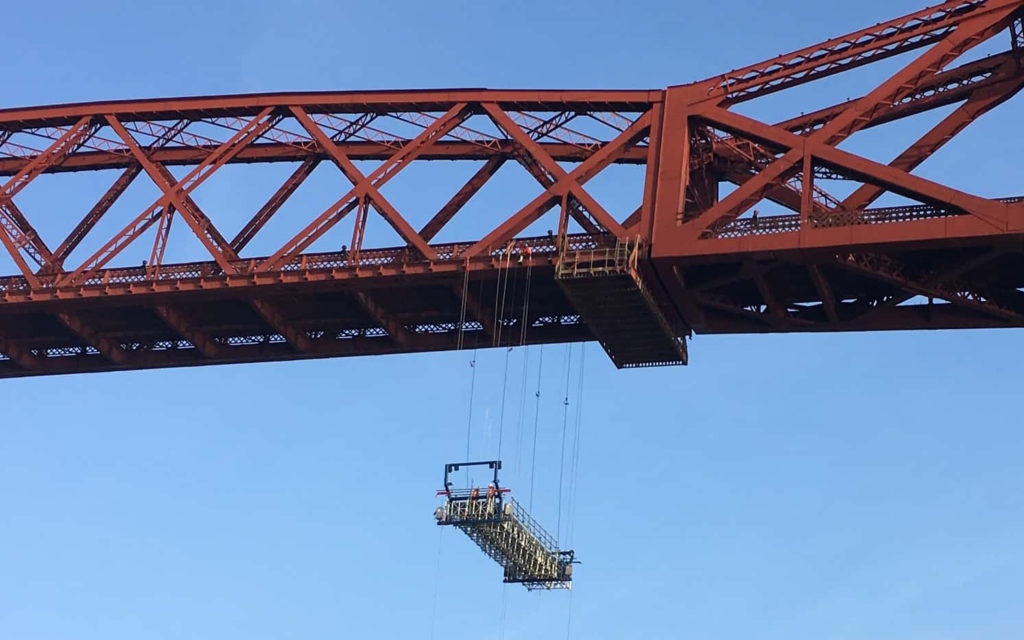
THE key point of a transport bridge is access for vehicles, which is why essential maintenance on the structures can become so problematic as commuters are forced to endure longer journey times for extended periods. One Scottish company, however, has been at the forefront of minimising closure times during the repairs of some of the country’s most iconic bridges.
“For us we look at everything with an innovative approach. Our overlying goals are to try to reduce working at height and reduce manual handling,” said Kenny Wiggins, chairman of Span Access – a company that has developed access solutions for projects such as the Forth Rail Bridge, the Forth Road Bridge and the Queensferry Crossing.
The firm, with bases in Kinross and Methil, is continually looking at alternative access methodologies rather than just using standard scaffolding for all the projects to which it is involved. As Kenny said, “Span develops solutions which are designed to fit the project and the structures involved” – no mean feat when you’re working on structures that are decades old and hundreds of feet in the air.
Take the Forth Rail Bridge project as an example. Few would have expected a boat to be used to help position the Span-designed platform some 150-feet in the air. But indeed, Span Access had its modular platform floating on a barge under the bridge, before it was raised and secured to the structure.
Kenny explained, “The innovative design we developed for the Rail Bridge had to consider the likely variation in the 137-year-old steel structure. Our system, which was well received by the client, allowed for offsite assembly, significantly less equipment than traditional methods and installation from a barge on the river.
“We needed a solution for the Rail Bridge that had no impact to the commuter and bringing a pre-built gantry up from the river satisfied that need. Once installed, our system was able to move along the underside of the bridge to allow the maintenance team access to the underside of the full south span. As well as facilitating easy access to the underside of the bridge, the moveable design allowed for the variation in dimensions of the iconic structure.
Kenny added, “With the gantry being raised into position in a single shift, it caused no restrictions to commuter traffic either on the bridge or on the water beneath with minimal aesthetic impact on the bridge, compared to what a full underdeck scaffold installation would have had.
The firm’s work on the Forth Road Bridge involved a unique hybrid system that, to Span Access’ knowledge, has never been tried before. Rigorous testing was undertaken, before a three-part system was set up for the remaining seven truss end link replacements. These had previously hit the headlines approaching the 2015 festive period when a crack in the first one had which resulted in the extended closure of the bridge.
“The work we did on the Forth Road Bridge included three different suspension mechanisms. We had a suspended platform and a suspended staircase to get to the platform – these two parts of the structure independently suspended. The additional complication on the Forth Road Bridge was that we also had a third working area in a tower which was suspended as well, and the main activity of work on the bridge was working off that tower,” Kenny added.
Given the work was being carried out in the middle of winter, conditions were naturally extreme – particularly at points as high as the Forth Road Bridge. The access system not only ensured extreme weather conditions could be handled, but that the weight of the five-lift scaffold could be held on the bridge.
“Now because each of the individual parts of the system were individually engineered, if you made any changes to one of them it didn’t affect the other two – so they weren’t integral to the overall structure, so changes could easily be made,” Kenny said.
“We were pushing the boundaries in relation to the technical aspects of it, and what I mean by that is because we had multiple separate suspensions. One of the biggest learnings was that the design time took a lot longer than we had expected it to take because there were more challenges with the permanent structure due to it being an older bridge.”
To demonstrate the diversity of Span’s strategy and versatility, a similar system to that of installed on the Forth Bridge was installed on the Magnus offshore oil platform. The firm was drafted in late to see if installation lead times and equipment mass could be reduced on what as a critical scope for the asset operator at the time, while also preventing damage to the critical anti-corrosion coating on the underside of the rig.
To mitigate any reservations of using a new methodology, Span Access set up the structure in its Kinross yard for the client and operator to review and test. This ultimately resulted in the system being used on the oil rig. With operator feedback on the system being, ‘This was a safer, quicker and an overall cheaper access solution. We need to use this methodology again’.
Kenny added, “With Magnus, the focus was to save time and provide a technical solution; we delivered the solution six weeks ahead of schedule – with the installation in location waiting on the equipment that was needed to do the replacement.”
Although having a portfolio boasting of work on some of Scotland’s most iconic structures, Kenny says the company continues to have growth aspirations both at home and internationally.









